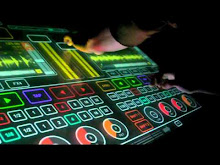
Brian Eno - 'Ambient 1: Music For Airports' (1978)

There are only a few artists I've really invested time into learning about and have listened to most of their music, and Brian Eno has been that archetype; he is a prolific figure whose work has accumulated to finally capturing an entirely subtle dimension of music appreciation and composition. No, Brian Eno did not invent Ambient music, instead he did something much more important which was to coin the term, and give a genuine, innovating purpose for music. Now, the environment was very much a product of the music because the listener had a much more important role, the listener is to perceive his environment as described by the music. Ambient music cannot be imposing, but still retain its dignity while it is ignored. The listener should use the music only as a catalyst for his perception, and not intend to entirely focus on the composition as it may lessen the stimulation from the environment.
Branching away, or more specifically, focusing further on abstract landscapes than pop music, Brian Eno's effort is a true masterpiece in the new era of modernism. The record is a transitional work, as it never grasp the listener entirely, but gives them enough to sense the warmth that pours throughout each note. Each piece is a subtle, placid one, but never in so much to become too homogeneous---truly, it is a unified work, with each piece working towards the effect of manipulating space and time. The purpose of the recording was to be used in mundane settings wherein activity was moving, even as uneventful as it was. Specifically, Eno wanted this recording to contrast with the uninspiring settings of hospitals and airports, places where people are in constant motion, or completely idle and feel at ease as the music is playing.
Released only a year after the advent of punk, historically, and significantly, Eno's recording works as foil to the simplicity of punk's ethos. What was currently in fashion was the rebelliousness of youth and a more active response to society. However, unlike the principles of that movement, ambient music chose not to direct the listener's emotions, but instead allow for the music itself to manifest through the realization of the listener. That is a brilliant paradox, for ambient music attempts to be an artwork that does not demand, but under scrutiny, Eno's work is an achievement on its own. For instance, "1/1," a piece composed by Eno along with Robert Wyatt and Rhett Davies, is an experiment in tape loops. The extended track at 17 minutes, it allows for the piano notes to work as an ostinato, while interacting with the different intervals of the other tonalities. In this process, the music, at chance, binds completely close, or drastically apart. Fundamentally, this composition of these pieces relies on only a few principles. One, the tonalities of each note, for instance the piano in "1/1" exhibits both forte and piano notes. Second, the tempo of the tape, and thus the instrument. Giving liberty to the tempo allows for an improvisational method of increasing the dynamics of each note. With this kind of tempo, which comes lastly is how the dynamic and timbre of each note changes, for they increase in volume or duration. As mentioned, the music are just loops, but with this method, the music changes drastically, in fact, it changes so much that no two notes are similar in any respect as soon as they are played.
The instruments in this record are very minimal, but are used efficiently. "1/1" employs the piano and synthesizer, while the following two tracks, "2/1" and "1/2" alternate between the interaction of the vocals. It is unbelievable as to how beautiful and colorful the timbre of the vocals are in both pieces. The melodies are at times conjuncted and very loud, or are slow, slightly detached and extremely soft. The human voice is just a far superior instrument than the synthesizer. However, the beauty of the synthesizer is not entirely overshadowed by the other two instruments as the final track includes only the synth. "2/2" creates the ambient musical world. The notes sound soft, warm, interweaving with each other only to forever become lost. The melody is nicely connected and its slow tempo allows for the beauty of building dynamics. It is almost impossible to not pay attention, for the attention to detail is magnificent. For its musical brilliance, Brian Eno's work is extremely contradicting, but its true success lies at its execution.
The beauty of Ambient 1: Music for Airports is how it is a living work, similar to a painting in a living room, or as rare and elegant as the moonlight bending through the cracks as an eternal ray. To ameliorate the setting, and to allow the human mind to add meaning to the music is an absolute accomplishment of Eno's work. For once, the intentions of the artist are no longer in his hands, as the work itself proves to be a piece for multi-purposes, never losing its dignity and continually proving to be a work of the modern space and time.
- youngprayer review from Rateyourmusic.com


No comments:
Post a Comment